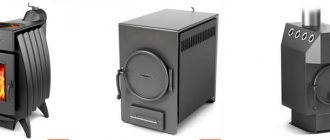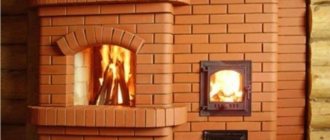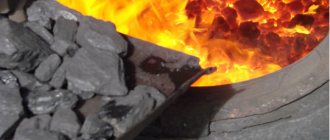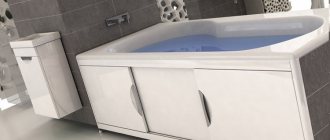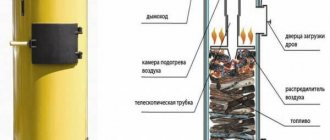Heating a country house and cottage during the cold season is one of the most pressing problems for any owner.
wood stove option for a summer house
Long-burning wood-burning stoves and fireplaces for summer cottages allow you to do this efficiently and economically. And the fact that you can fold them with your own hands makes this design one of the most popular among homeowners.
In this article we will describe in detail step-by-step instructions for laying a fireplace stove for a summer house, and find out what the technical features of the design are.
You can view and choose a suitable fireplace stove for your dacha at https://www.teplodar.ru/catalog/section/otopitelnye-pechi-i-kaminy/filter/type_furnace-is-pech_kamin/apply/
The operating principle of a long-burning fireplace stove
Analyzing in detail the diagram of the fireplace and stove, we have repeatedly said that one of the main elements of the heating structure is the firebox, chimney and ash pan.
So, the peculiarity of long-burning stoves is precisely that they do not have an ash pan through which cold air is drawn in.
Diagram of a long-burning furnace
The ash pan not only serves as a ash pan, but also allows for systematic cleaning of the fireplace from ash and ashes. Here the principle of operation is such that there are practically no combustion products left.
And the wood-burning stove is supplied with oxygen, which is directly involved in the combustion process of the stove, through a special hole. This is a kind of supply pipe that allows you to regulate the flow of oxygen and, accordingly, influence the combustion intensity of the stove.
Long burning cast iron stove
The key to a long-burning fireplace stove is the need to provide sufficient oxygen. This will allow you to maintain stable combustion of the fuel in the chamber and ensure economical consumption of firewood.
The operating principle of a long-burning wood-burning fireplace stove is similar to a pyrolysis unit, where the main heat is generated not from the combustion of wood or coal, but from the gasification of solid fuel. And although in this article we are considering structures heated with wood, the principle for all long-burning units will be similar.
The combustion process itself takes place in a closed space, from where wood gas is released through a special pipe. Then the heated gas goes to the second, where it mixes with secondary air pumped in by a fan.
This ensures a continuous process that continues until the wood is completely burned. In this case, the combustion temperature sometimes reaches 1200 degrees. In this case, raw materials are consumed very slowly, as needed, which significantly increases the efficiency of such a fireplace stove.
The high efficiency (80-85%) of long-burning fireplace stoves is also achieved due to the favorable location of the heat exchanger, which is a water jacket.
The device helps to evenly heat the water circuit around the entire perimeter, increasing heat transfer. The temperature of the exhaust gases usually does not exceed 130-150 degrees. The heat released in the fireplace warms up the coolant as efficiently as possible.
Furnace design
Considering that smoldering occurs extremely slowly, long-burning fireplaces, unlike pyrolysis stoves and boilers, are not so demanding on the quality and moisture content of the fuel. Of course, productivity will also decrease with wet wood (more than 30%), but it will not drop as much as in a pyrolysis boiler.
Many models work on the basis of bulk wood substances (sawdust, wood chips), on peat briquettes or on the basis of wood pieces and sections. But these are rather factory models. But it is better to heat structures made by yourself with wood.
The long-burning stove model itself appeared on the market relatively recently. At the beginning of the 21st century, the Stropuva company, thanks to engineer Edmuntas Štropaitis, found a solution to the problem of constantly adding fuel to the boiler.
It was he who first came up with the idea of supplying oxygen from above, which made long-term combustion possible. Today, this is the most practical device for heating a summer house, the performance level of which reaches 70 and sometimes 100%.
Ready-made portable options
Small fireplaces that can be easily transported to any place will help you quickly create a cozy atmosphere in a small country house. Let's look at their main types:
- Metal or cast iron wood burning fireplace. It is unrealistic to transport it constantly as you visit the dacha, but its dimensions allow it to be installed in rooms that lack free space. The disadvantage of a cast iron wood-burning device is the need to construct a chimney. This is done once, so you can try to not only look at the fire, but also heat the entire room with it.
- A special mini fireplace for a country house, powered by biofuel, is convenient and compact. You can bring it with you every time and install it in the kitchen, bedroom, or hallway. In a word, move it to your place of residence. However, such models are not capable of heating a house, even a country house. In addition, you will also have to bring fuel for them with you.
- Electric fireplace, built-in or free-standing. A variety of models will allow you to choose the option that suits your room. There are two outcomes here: buy a free-standing mini fireplace or design a portal for a built-in one. This portal can be of the smallest possible size so as not to lose the usable area of an already small room.
Electrical analogue of the traditional system
Almost all of the listed options are not inferior in their functions to real fireplaces and can easily cope with a room of 15-20 m2. In addition, do not forget about the appearance and combination of the device with the interior. A summer house is not always a temporary place for storing agricultural tools. In most cases, it represents a full-fledged house or cottage, which is decorated in a single key. Therefore, choosing a fireplace should be treated like painting a picture.
Good to know: Cast iron fireplace for home and garden - an inexpensive heater and decorative element
Based on the appearance of portals for mini-fireplaces, the following styles are distinguished:
- Classical. The portal is made in the shape of the letter “P” and decorated with stucco.
- Rustic. Has a podium. As a result, “P” is transformed into “D”.
- High tech. It is distinguished by its severity, consistency, and the presence of metal and glass surfaces.
- Bionics. Graceful curves are transferred even to the outer borders of the portal. Relatively young style.
As you can see, you can choose not only a functional, but also a beautifully designed, stylish fireplace, quite suitable for summer cottages. But this option is not the only one. Many summer residents are interested in the question of the possibility of independently designing a fireplace.
Compact whole house heater
Design Feature
But not only high performance is the advantage of this design.
The whole point of long-term burning is that not the entire stack of firewood burns out at the same time, as happens in a classic stove, but only the top layer.
Principle of operation
This becomes possible due to air intake from above, and not from below through the ash pan. Thus, fuel combustion occurs gradually, in its upper layer. When this layer burns out, a new portion of oxygen is supplied through the regulator, and exactly as much as is needed for the combustion of the top layer. This ensures such a burning duration and the ability to control the process.
The main point in a fireplace stove is maintaining long-term combustion, during which the fuel elements completely disintegrate. As a result of this process, large volumes of hot gases are formed and a large amount of heat is steadily released.
The implementation of secondary afterburning occurs in the second chamber (upper).
In the fuel chamber, where the firewood is placed, the primary combustion of the fuel occurs. Hot smoke rises up the pipe and burns out completely. To stimulate the secondary combustion of wood, the design provides for the presence of pipes through which oxygen flows.
Today, two long-term combustion systems implemented in such devices have become widespread. These are the Canadian system Buleryan and the Baltic Stropuva. At the same time, the Burelyan system is very popular in our country due to its small dimensions and low price. But the Stropuva system is less common due to its high price and large number of technical parameters.
Traditionally, the Burelyan system (this is the technology that will be used in the long-burning stove-fireplace we are describing) is a small stove consisting of two chambers.
The main combustion of wood occurs in the lower chamber, resulting in the formation of wood gas. When heated, it rises and enters the second chamber, which is located above the first.
Scheme of a stove with a long-burning hob
Here, diffusion of hot gas with air and secondary combustion occur.
Another difference from a traditional fireplace stove is the location of the firebox door. If it is usually attached from below, then here the design will be slightly different.
The burning time itself suggests that the process will require a large amount of firewood, which must be located somewhere.
It is for this purpose that the lower chamber (or firebox) should be large, and the door through which firewood is placed should be located high enough.
Features of a long-burning stove
In a fireplace stove, the ash pan plays a purely technical role and is intended to clean the stove from residual ash, of which very little remains after double combustion of the fuel. Considering the fact that air enters through a special hole located in the upper part of the furnace, the ash pan door must be absolutely sealed.
Otherwise, there will be no question of any long-term combustion if oxygen comes from below the stove.
So, summarizing the design features of a long-burning fireplace stove, we can highlight the following points:
- large volume of combustion (loading) chamber;
- dividing the main firebox into two parts: upper and lower chambers;
- lack of blower;
- adjustable oxygen supply from above.
The higher the humidity of the wood, the lower the efficiency of the stove will be. Therefore, for combustion it is recommended to use fuel with a moisture content of no more than 20%.
What size house can be heated with a brick stove with a water circuit?
A brick stove can also be adapted for heating large areas if, when building it, a heat exchange element is placed near the firebox through which the coolant will pass, heating up and then circulating in the heating system distributed throughout the house. In this case, you may need to connect a water pump, which will accelerate the movement of coolant in the system.
Homemade efficient heat exchanger
Heat exchange elements can be of different shapes; the photo shows one of them. It is embedded in the structure of the stove near the combustion chamber so that, passing through it, the water quickly heats up and enters the pipes and radiators.
The inlet and outlet pipes from the heat exchanger are led outside the furnace structure, and the heating circuit is connected to them. Next, the system is filled with water, which will act as a coolant.
Wiring can be done using metal-plastic or polypropylene pipes
In this case, metal-plastic pipes are used for wiring and connection to the circuit.
Diagram of a wood stove with a water heating circuit
In this diagram, the heat exchanger is located above the firebox and is shown as a red grate. The blue line marks the cooled coolant, which passes through the circulation pump and enters the heat exchanger - this part of the circuit is called return. The red line marks the heated water entering the radiators.
A membrane tank is also installed in the heating circuit, which can be located in any accessible location in the circuit, but it is advisable to install it on the return pipe.
Diaphragm tank
It is also called a closed expansion tank. There is a nipple on its upper part, through which air is pumped into the upper chamber. When water in the system heats up, it expands and excess water rises into the tank, stretching the membrane. When cooling and the corresponding pressure drop, water is pressed back into the system. In this way, possible pressure surges in the pipes are smoothed out, and the risk of destruction of the integrity of the system from overheating is minimized.
Video sketch: an interesting version of a fireplace stove with a heating circuit
Advantages and disadvantages of a long-burning fireplace stove
The design feature and operating principle of a long-burning fireplace stove determines its following advantages:
Advantages of long-burning stoves
- High performance and efficiency.
- Autonomy of work. The fireplace stove can act as the main heating device.
- Economical fuel consumption.
- Environmental friendliness of the heating process.
- Complete combustion of fuel, which means almost complete absence of ash.
- Fast heating of the room.
- Saving time and resources.
- Ease of use. A good long-burning fireplace stove can operate for 6-8 hours from one load of firewood, without additional human intervention.
Flaws:
- High price compared to a regular classic fireplace stove.
- Given the long combustion process and the large volume of the loading chamber, the chimney should be as high and straight as possible.
- A homemade long-burning fireplace stove does not have a particularly decorative appearance.
This type of fireplace stove is ideal for heating a home. But if the stove is needed for cooking food or heating water, you should look for other options.
Advantages of the structure
While the difference between two specific models may be noticeable, there are some properties that are common to fireplaces using this type of fuel.
Advantages of wood-burning fireplaces:
- naturalness;
- low price of wood;
- autonomy;
- variety of shapes and sizes;
- comfort and coziness in the room.
I would especially like to highlight safety. The production of components for home fires is carried out on automated production bases with minimal human intervention. To ensure reliability and eliminate defects, strict quality control is carried out. Manufactured products comply with fire safety standards. For these purposes, manufacturers are introducing double combustion systems, temperature sensors and much more.
Fig. 4 An example of arranging a recreation area
In most cases, equipment can operate without constant supervision by the owner.
Types of fireplace stoves
Today on the market you can find many types of long-burning fireplace stoves, which differ not only in material, but also in size and method of purpose.
Classification by materials
- Cast iron. One of the most popular models, characterized by high performance and durability. Their only drawback is their heavy weight and high price. One such stove will weigh at least 300 kg, so before installation you should take care of a solid base and strengthen the floor.
Despite some differences in modification and style, the operating principle of cast iron long-burning fireplace stoves is the same.
Cast iron stove
Some fireplaces are equipped with a glass door, which allows you to use the stove not only as a heating device, but also to sit comfortably in front of it, admiring the flames.
On the market you can also find long-burning models equipped with a hob, which use the principle of convection heating in their operation.
Cast iron stoves and long-burning fireplaces, depending on the size of the loading chamber and modification, are capable of operating on one load of firewood for up to 10 hours without intervention.
But for this, a mandatory condition must be met. The humidity of firewood placed in the firebox should be no more than 25%. Otherwise, the productivity of such a stove will drop sharply, and the firewood will quickly burn out.
When making your own long-burning cast iron stove, use material with a thickness of 6 to 25 mm. This design is not suitable for heating a large room, since cast iron has low thermal conductivity.
The advantage of this design is resistance to long interruptions in operation and resistance to corrosion. Paint, which may lose its appeal over time, is always easy to refresh.
When purchasing a cast iron long-burning wood stove with a hob, it is worth remembering that cast iron is a fairly fragile material. It is afraid of sudden changes in temperature; if it cools suddenly, cracks may appear on it. You should also not allow cold water to spill on a surface made of cast iron.
With proper care and proper operation, long-burning cast iron stoves and fireplaces can last for decades, giving dacha owners comfort and warmth.
Long burning steel stove
- Steel. Unlike cast iron units, they cool faster and, accordingly, have less heat transfer. And in terms of durability they are inferior to their cast iron counterparts.
- Ceramic. Such stoves look very stylish and are not very heavy, which means there is no need to create a separate base for them. The only drawback is the high price and fragility of the structure.
Ceramics
If metal stoves can be easily dismantled, transported and reinstalled without damage to integrity and without loss of functionality, then this is difficult to do with a ceramic stove.
- Combined. Such structures are usually made of cast iron and steel.
Metal is in no way inferior in its characteristics to ceramic models. It lends itself perfectly to heat treatment, which allows you to create a fireplace of any configuration. An undeniable advantage of long-burning metal fireplaces is their high productivity, which ranges from 85-90%.
If you make a stove of the same design from brick, its maximum efficiency will be 65-70%. That is why sheet metal is used to make such stoves with your own hands.
The metal stove heats up quickly, which allows you to quickly warm up your home upon arrival at your dacha during the cold period.
For comparison, in a brick stove of the same design, about 25% of the thermal energy will be lost to the atmosphere along with the smoke until it completely warms up and begins to release heat into the room.
Here the metal immediately begins to give off heat.
The metal does not become damp during downtime, which is especially important for dacha owners in the off-season period, when the owners go out into nature from time to time. Such a fireplace can be lit immediately in a cold and cold house, without preliminary heating fireboxes.
Due to the lack of heat flows in a metal furnace, flue gases quickly burn out within a small space. Therefore, by integrating additional parts in the form of a water circuit for heating water or heating a room, you can achieve much greater efficiency compared to its brick counterpart.
Long-burning brick stove
- Long-burning brick stoves have a complex design and are laid out by hand on a separately built foundation. The main technical characteristics and performance of such structures directly depend on the skill of the stove maker.
Classification by purpose
- Long-burning heating stove-fireplace. The most popular and simplest option, sold in metal, cast iron or brick. It has a fairly high efficiency (80-85%) and is used exclusively for heating the room. It has compact dimensions and is suitable even for tight spaces. Typically, all models have a niche for firewood and a compartment for ash accumulations.
- Heating and cooking. This option can be found in cast iron and steel.
Oven with hob
The design allows you to heat water or even cook food, which will help reduce energy costs.
- Models with built-in oven. In such an oven you can make homemade baked goods.
Also, fireplace stoves differ according to the type of fuel used. There are combined models, which are the most practical solution, allowing you to heat your home with peat briquettes and firewood.
But in most cases, fireplace stoves are initially designed to burn a specific fuel.
Water loop design
A separate group of long-burning furnaces includes a design with a water circuit. This fireplace stove has many advantages. According to the principle of operation, this device resembles a solid fuel boiler.
The high performance of such furnaces is achieved due to the favorable location of the heat exchanger.
The design of the fireplace helps to heat the water jacket evenly around the entire perimeter. The temperature of the exhaust gases does not exceed 130-150 degrees. Due to this, the heat released in the furnace heats the coolant as efficiently as possible.
Due to the complexity of the design and volumetric dimensions, stoves with a water circuit are mainly used for heating large rooms and large country mansions. For a small dacha or a one-story house, it is simply not economically rational to purchase such a fireplace.
Classification by type of firebox
This classification is already of a technical nature and can be used when necessary to calculate the required device resources.
- Closed fireplaces represent a large subclass of devices in which the firebox is protected by glass. They are built into recesses or niches in the wall or prepared portals. But constructing such a structure is not so easy. The wall must have a chimney that meets all the requirements for wood-burning fireplaces.
- Semi-closed fireplaces may not have not only a facade, but also one of the side walls. Typically, such devices are wall-mounted according to the installation method. This means that the chimney is not mounted in the wall, but is attached to it. Semi-closed fireplaces are popular in cottage furnishings, as they can be installed near corner walls with an outer corner, which is typical for this type of building, and radiate heat into two adjacent rooms at the same time.
- Open fireplaces are considered more realistic, and this is perhaps their only advantage. The efficiency of such fireplaces is low, since a large amount of heated air goes into the chimney, which means energy is lost. In addition, open fires often cause fires. To ensure safety, it is necessary to make a section of the floor covering from a heat-protective material, which will protect against fire if smoldering logs fall on the floor.
Typical country house interior
Choosing a long-burning stove-fireplace for a summer residence
As mentioned above, today you can buy a ready-made cast iron or steel stove structure - a long-burning fireplace for a summer residence, which will not be difficult to install in the house.
Long burning wood stove
Let's look at the main selection criteria and look at the points you should pay attention to when purchasing.
- Type of fuel.
This is one of the key points on which the effectiveness of the device depends. Not all raw materials are designed for long-term combustion. Firewood produces maximum performance when it burns quickly. But peat briquettes can give off heat for a long time, maintaining the desired temperature.
- Boiler material.
An important parameter that affects the combustion duration and heat transfer efficiency. Today the market offers products made of steel, cast iron, and ceramics. Cast iron structures are more suitable for heating with wood.
The choice of stove material largely depends on the budget. Ceramic models cost quite a lot, but at the same time they do not in any way exceed the characteristics of cast iron or metal ones.
- Furnace power. This parameter depends on the volume of the loading chamber, so when choosing, pay attention to its dimensions. The larger it is, the longer the boiler can burn with one load. This also ensures ease of use, because then you won’t have to throw new logs into the firebox every 2-3 hours.
- Structure weight.
This criterion is important during installation. A cast iron fireplace will be almost 20% heavier than a steel one. Therefore, if you do not need to strengthen the floor, then it is better to give preference to a lighter steel stove.
- Product price. This, of course, is a very conditional parameter. But if you use a fireplace stove as the main source of heating, then you should not save.
Homemade design
A long-burning cast iron fireplace stove is the most optimal solution for heating a small house, representing something in between an expensive TT boiler and a conventional stove.
This design will allow you to efficiently heat the house, using a minimum of effort and raw materials. In addition, a modern model of such a fireplace will become a decorative highlight in the interior and will create an atmosphere of home comfort.
For proper and long-term operation, it must be cleaned of ash, not forgetting the chimney.
Choosing a heating system depending on the size of the house
- For small, well-insulated houses, consisting of one or two rooms and a kitchen, one heating and cooking stove made of brick will be sufficient.
- For larger buildings, it is necessary to carefully consider the heating system so that the entire house can be heated from one stove. For this purpose, heating is used using a water or steam circuit.
- For a one-story building, such a circuit can be connected to a brick stove or one made of cast iron. When installing a system in a two- or three-story house, a cast-iron stove-boiler is more suitable.
The next thing you need to decide is the type of fuel. The system can be heated with wood, coal, peat, gas, diesel, electricity or several of them. This choice will determine which heating stove to purchase.
Apartment design with a fireplace
A fireplace is a decoration for any room. It is only important to choose the right option that is suitable for the room.
In an old building with a chimney, you can design a wood-burning fireplace, always from fireproof materials. It will allow you to create a modern interior in your apartment at a minimal cost.
There are a wide variety of interior solutions when decorating a room with a fireplace, for example, designing a kitchen-dining room with a massive large fireplace and many storage systems in a strict geometric style.
You can decorate your apartment and fireplace in a hunting style: a rocking chair, a chandelier on a massive chain, a stuffed deer or antlers, an antique carpet. This design will be reminiscent of Victorian England and will amaze all guests with its sophistication and taste.
view album in new window
The design of the fireplace with wooden panels on the walls and luxurious doors is also very original. Such simple materials will help create a unique interior.
There is an option for designing a studio apartment with a fireplace as an object separating two rooms. The fireplace is installed in a partition that separates one room from another. This option is both very aesthetic and functional. A design solution could be cladding with pebbles or stone, and it will be possible to warm up and admire the fire from two rooms at once.
To decorate in a royal style, you can use large stones or materials that replace natural stone. This fireplace is suitable for both antique furniture and modern interiors. In this case, crystal, ivory, porcelain figurines, mirrors and gilding are used as decorative elements.
Decorating an apartment in a high-tech style requires an appropriate fireplace: without unnecessary decor, restrained color, with a predominance of straight lines. This solution may seem boring to some, but high-tech fireplaces have a number of advantages:
view album in new window
- wide variation of fire displayed;
- living flame function;
- heating the front glass with infrared radiation.
Some manufacturers of such fireplaces offer unusual options, for example, with the function of depicting burning logs.
An interesting design idea is to decorate a fireplace in a country style using wooden panels, natural stone, and brick. In this case, painted plates, photo frames, forged candlesticks and natural pine cones in containers are also used for the interior.
view album in new window
Fireplace in the living room in the apartment
Installing a fireplace in any part of the apartment depends on its type. The most common room for installation is the living room; this is where you can create the desired coziness with the help of a fireplace. Fire pacifies, calms, relaxes. It is in the living room that you want to hold family or friendly gatherings by the fire.
view album in new window
The fireplace can be placed in the corner of the living room. This is suitable for those who want to save space. You can also place a fireplace in the center of the wall, placing upholstered furniture, tables and shelves around it. It is not recommended to install a fireplace near an external wall, since a significant part of the heat will go outside and not into the house.
To position the fireplace, it is necessary to make partitions with special holes and heat-resistant glass. The partition can be made of stone, brick or tile.
A wall-mounted electric fireplace can be installed in any room, but it will look most appropriate in the living room.
A gas fireplace will also look best in the living room, but with the right design can be installed in any other room.
view album in new window
The main decoration of the fireplace is a live fire, creating decorative lighting in the room. This is why all lighting in the living room must be carefully planned. You can use lamps made of Murano glass or pearl white plastic. Lamps should not cast light onto the fireplace fire, especially if it is a fake fire, otherwise glare will form. The lighting should be soft, for example, using a floor lamp or lamps built into the ceiling.
When planning lighting, do not forget about the need for ordinary classic lighting for the convenience of all family members.
When I plan to install a fireplace, it is also important not to forget about the fireplace area. A recreation area should be provided. This could be a pair of soft armchairs with a small coffee table, or a rocking chair with a checkered blanket and a round table on a high leg where you can put knitting and a mug of tea. It is also worth thinking about decorating the wall with paintings or photographs, figurines and vases.
view album in new window
False fireplace or imitation fireplace, what to choose?
Laying a real fireplace is an expensive pleasure, not available to owners of standard apartments, especially in panel houses, due to the increased load. The solution in this case could be a false fireplace that runs on electricity and simulates the burning of a flame. At the same time, you will not have problems with the delivery of firewood, smoke, soot, and you will not have to coordinate this work with anyone. A modern electric fireplace looks quite natural; the main thing is to make a suitable frame, or portal. It is most often made from available material - plasterboard, mounted on a profile frame, and then finished to your taste.
Technology for building a false fireplace in an apartment
- Draw a sketch of the fireplace and choose the finishing material - the thickness of the drywall will depend on it. For finishing with decorative stone or porcelain stoneware, it is better to choose plasterboard with a thickness of 12 mm; for lighter materials, a thickness of 8 mm is also suitable. Indicate all dimensions on the sketch and calculate the amount of material. The sketch must include a place for installing an electric fireplace in compliance with the clearances specified in the passport.
- Where the fireplace is installed, it is necessary to level the floors if necessary, and also provide a place for connecting electrical appliances. A frame is made from a profile for plasterboard according to the sketch, fastening it with metal screws. If it is necessary to make roundings, the U-shaped profile is cut with metal scissors along the sides and bent to the required radius.
- Pre-cut plasterboard parts are attached to the profile frame. Drywall is quite easy to cut with a sharp, thin knife. The sheets are fastened with hardened self-tapping screws. The seams are puttied using sickle tape. They attach finishing and decorative elements, stucco molding, and a mantelpiece. Internal lighting can also give your fireplace a unique style and originality.
- Install the electric fireplace in the “firebox”, connect it to the electrical network, and if there is simulated smoke, to a water source.
The technologies presented are, of course, not dogma. Your imagination will tell you which fireplace will look more original: corner or classic English, and will also tell you how best to decorate it, what accessories to choose and how to decorate the mantelpiece. The main thing is that with the advent of a fireplace, warmth and unprecedented comfort will reign in your apartment.
